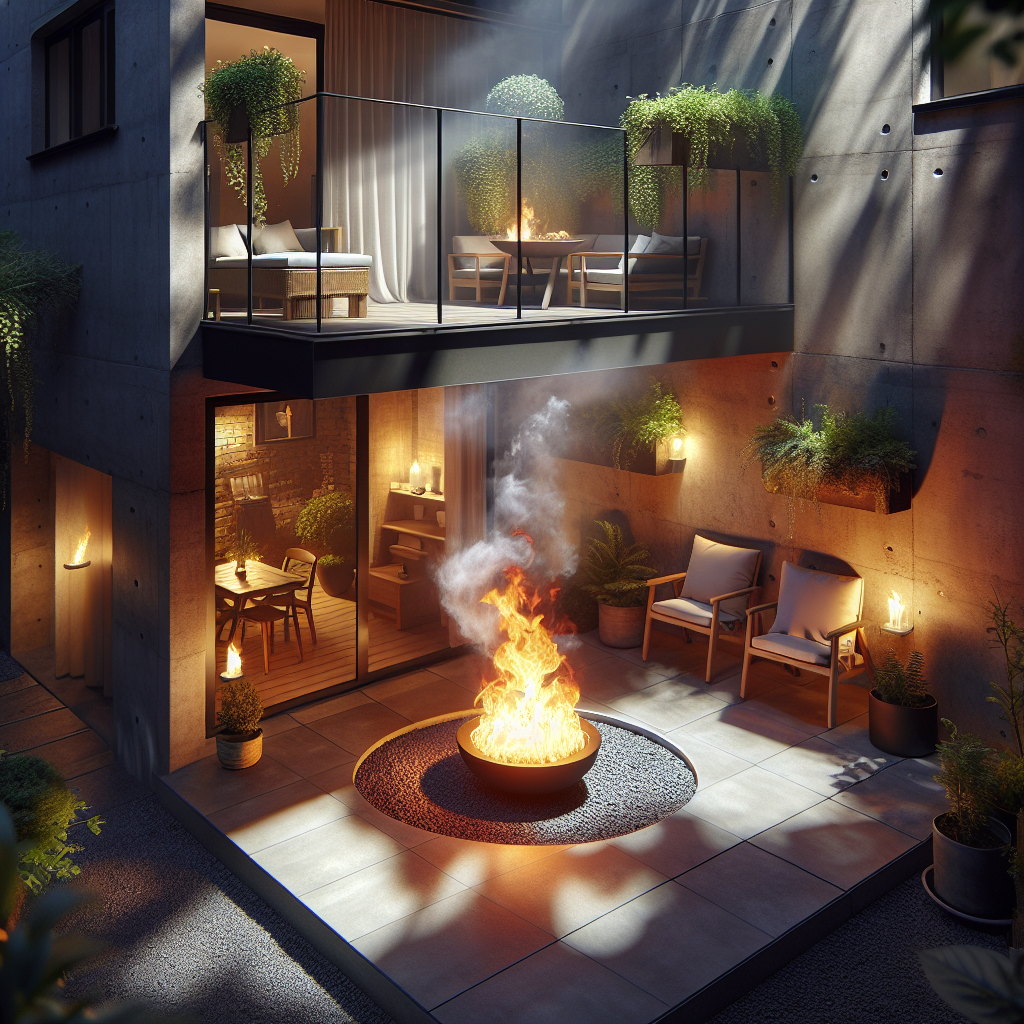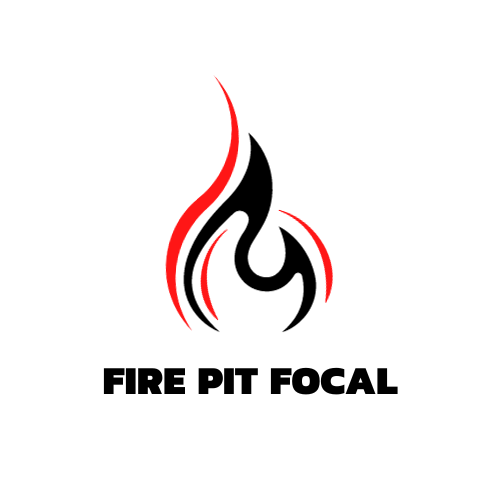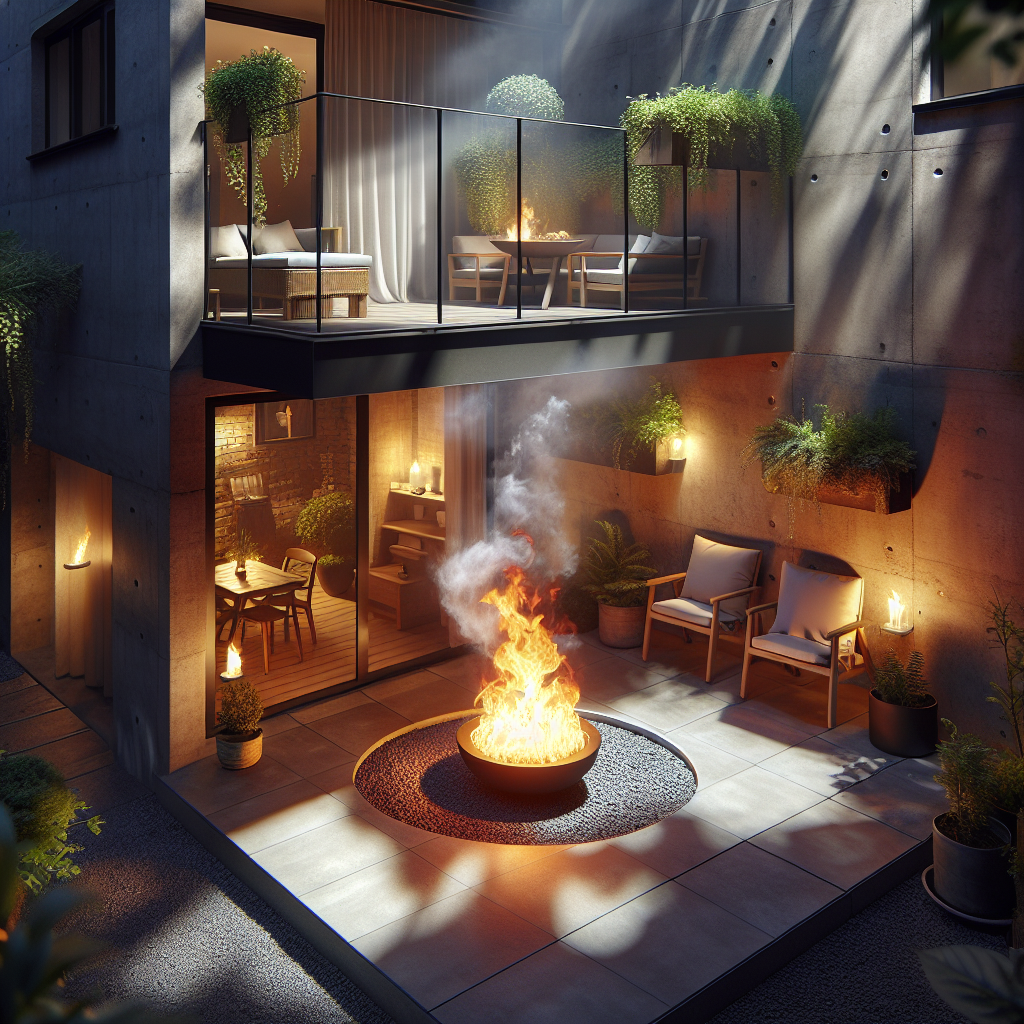Imagine sitting outside on a cool evening, surrounded by the warm glow of a crackling fire. The flickering flames and the comforting heat create the perfect ambiance for relaxation and gatherings with friends and family. But before you rush to set up a fire pit in your small backyard or on your balcony, it’s important to know whether it’s permissible and safe. In this article, we will explore the factors to consider and the options available to help you enjoy the cozy appeal of a fire pit in your compact outdoor space.

Safety Considerations
Fire Pit Location
When considering using a fire pit in a small backyard or on a balcony, the first and most important safety consideration is the location of the fire pit. It is crucial to choose a suitable spot that is away from any flammable materials, structures, or overhanging trees. You should ensure that there is enough space for people to move around comfortably and that the fire pit is positioned on a stable surface.
Fire Pit Size
The size of the fire pit is another crucial factor to consider when using one in a small backyard or on a balcony. It’s important to choose a fire pit that fits the available space appropriately. A fire pit that is too large can pose a safety hazard and overwhelm a small area, while one that is too small may not provide enough heat or ambiance. Consider the dimensions of your space and choose a fire pit size that best suits your needs.
Clearance Requirements
Clearance requirements refer to the amount of space required around the fire pit to ensure safe operation. It is essential to maintain safe distances from any nearby structures, including fences, walls, or buildings. Additionally, there should be no obstructions in the surroundings that may catch fire, such as dry grass or debris. Adequate clearance ensures that you can enjoy a fire pit without putting surrounding materials or structures at risk.
Fire Pit Type
Choosing the right fire pit type is crucial for safety and functionality. There are various options available, including portable fire pits, built-in fire pits, chiminea fire pits, tabletop fire pits, and fire pit tables. Each type has its own set of safety considerations and advantages. Consider factors such as portability, heat output, and fuel type when selecting the appropriate fire pit type for your small backyard or balcony.
Fire Pit Fuel
The fuel used in a fire pit is an important consideration, as it affects both safety and convenience. Wood-burning fire pits provide a traditional and cozy experience, but they require regular maintenance, including proper storage of firewood. Propane fire pits offer convenience and control, as they can be easily turned on and off. Natural gas fire pits provide a constant fuel supply but may require professional installation. Ethanol and gel fire pits offer a clean-burning, odorless option but have a lower heat output. Consider your specific needs and the pros and cons of each fuel option before making a decision.
Fire Pit Location
Backyard Considerations
When using a fire pit in a small backyard, several considerations come into play. Evaluate the available space to ensure there is enough room for people to gather comfortably around the fire pit. It’s also important to assess the distance from structures to ensure safety. Ideally, the fire pit should be placed away from any flammable materials, such as overhanging trees or wooden structures. Additionally, consider the ground surface, as placing a fire pit on a nonflammable material, like a stone patio, is safer than on grass.
Balcony Considerations
Using a fire pit on a balcony requires additional considerations due to the limited space and potential impact on neighboring units. Check the size and load capacity of your balcony to ensure it can support the weight of a fire pit. It’s crucial to consult your neighbors and comply with any regulations or restrictions set by your building or homeowner’s association. Consider fire safety measures such as having a fire extinguisher readily available and ensuring that smoke can be safely dispersed in the event of wind patterns or lack of ventilation.
Local Regulations
Before using a fire pit in a small backyard or on a balcony, it is essential to research and comply with local regulations. Different cities and municipalities may have specific rules regarding the use of fire pits, including restrictions on fuel types, clearance requirements, and even the need for permits. Checking local laws ensures you can safely and legally enjoy a fire pit in your small outdoor space. Additionally, be aware of any potential noise complaints or smoke nuisance issues that may exist within your locale.
Neighboring Structures
When using a fire pit in a small backyard or on a balcony, it is important to consider the impact on neighboring structures. Ensure that the fire pit is positioned in such a way that it does not pose a risk to nearby fences, walls, or buildings. Wind patterns should also be taken into account, as they can carry sparks or smoke towards neighboring properties. Being considerate of the safety and comfort of your neighbors will help foster a harmonious living environment while enjoying your fire pit.
Ventilation
Proper ventilation is crucial when using a fire pit in a small backyard or on a balcony. Adequate airflow helps disperse smoke and prevents it from accumulating in the surrounding area. In a backyard, natural ventilation can be achieved by leaving ample space around the fire pit and ensuring there are no obstructions or structures that hinder the airflow. On a balcony, consider options such as open railings or ventilation systems specifically designed for outdoor fire pits. Ventilation plays a key role in ensuring a safe and enjoyable fire pit experience.
Fire Pit Size
Choosing the Right Size
Selecting the right size fire pit is essential for a small backyard or balcony. Consider the dimensions of your space and choose a fire pit size that fits comfortably in the available area. A fire pit that is too large may overpower the space and make it feel cramped, while one that is too small may not provide enough heat or ambiance. Strike a balance between size and functionality to ensure a pleasant and safe fire pit experience.
Space Limitations
A small backyard or balcony naturally presents space limitations when using a fire pit. It is important to carefully measure the available area and select a fire pit that fits within those dimensions. Be mindful of the space required for people to move around and sit comfortably. Consider compact or portable fire pit options that can be easily stored or moved when not in use. Adhering to the limitations of your space will help create an inviting and safe environment for fire pit enjoyment.
Heat Output
The heat output of a fire pit is an important consideration when choosing the right size. Evaluate your desired level of warmth and ambiance to determine the appropriate heat output. Keep in mind that a larger fire pit generally produces more heat, but this may not be necessary for a smaller space. Consider the fuel type as well, as different fuels can affect the heat output. Strike a balance between comfort and appropriate heat for your specific space.
Fuel Efficiency
Fuel efficiency is another aspect to consider when selecting the size of a fire pit for a small backyard or balcony. Consider how frequently you plan to use the fire pit and the cost and availability of the fuel. Larger fire pits may consume more fuel, which can be a consideration if you have limited storage space for wood or if you are using a fuel type that requires refills. Finding a size that balances the desired usage and fuel efficiency will help maximize your fire pit experience.
Customizable Options
Many fire pits offer customizable options that allow you to adjust their size and features. Some fire pits have adjustable grates or grills, allowing you to control the size and intensity of the fire. Others may have modular designs that can be expanded or contracted to fit different spaces. Consider these customizable options when selecting the size of a fire pit, as they can provide versatility and adaptability to your small backyard or balcony.
Clearance Requirements
Maintaining Safe Distances
Clearance requirements refer to the space needed between the fire pit and surrounding structures or materials to ensure safe operation. It is crucial to maintain safe distances to prevent accidental fires. Follow specific guidelines provided by the fire pit manufacturer or local regulations, but as a general rule, a minimum distance of three feet is often recommended. This includes maintaining a safe distance from fences, walls, trees, and any other potentially flammable structures.
Obstruction-Free Surroundings
In addition to maintaining safe distances, it is important to keep the surroundings of the fire pit free from obstructions. Ensure that there are no overhanging branches or other obstacles that could catch fire or obstruct the movement of people around the fire pit. Regularly inspect the area and remove any debris or flammable materials that may have accumulated. An unobstructed environment around the fire pit enhances both safety and the overall enjoyment of the experience.
Protecting Combustible Materials
Clearance requirements are especially crucial when considering the proximity of combustible materials to the fire pit. Take caution to ensure that there are no flammable materials in the immediate vicinity. This includes patio furniture, plants, cushions, and other objects that could ignite from the heat or sparks of the fire pit. Protecting combustible materials is essential for fire safety and prevents the risk of accidental fires or damage.
Considering Wind Patterns
When choosing the location and clearance requirements for a fire pit, it is important to consider wind patterns in the surrounding area. Wind can blow sparks or embers towards nearby structures or materials, increasing the risk of a fire. Evaluate the prevailing wind direction and choose a location that minimizes the exposure of the fire pit to the wind. Considering wind patterns will help create a safe and enjoyable fire pit experience for you and your neighbors.
Fire Extinguisher Accessibility
Having a fire extinguisher readily accessible is an important safety consideration when using a fire pit in a small backyard or on a balcony. In the event of an emergency or accidental fire, a fire extinguisher can quickly suppress flames and prevent the situation from escalating. Place a fire extinguisher within easy reach of the fire pit and ensure that all users are familiar with its operation. This additional safety measure provides peace of mind and enhances overall safety when enjoying a fire pit in a small outdoor space.

Fire Pit Type
Portable Fire Pits
Portable fire pits offer flexibility and versatility for small backyard spaces or balconies. They can be easily moved and stored when not in use, making them ideal for those who have limited space. Portable fire pits come in various sizes and styles, allowing you to choose one that fits your specific needs and aesthetic preferences. Additionally, many portable fire pits are designed with safety features such as spark screens or lids to contain the fire and prevent accidental injuries.
Built-In Fire Pits
Built-in fire pits are a popular choice for homeowners looking to create a permanent fire pit feature in their small backyard. These fire pits are typically installed into the ground or built into a patio or outdoor structure. Built-in fire pits can be customized to fit the available space and can incorporate additional features, such as seating or cooking grates. However, it’s important to consider the long-term commitment and potential limitations of a built-in fire pit, as they may not be suitable for balconies or rental properties.
Chiminea Fire Pits
Chiminea fire pits are distinctive in their design, featuring a bulbous body with a chimney-style vent. These fire pits provide both warmth and an aesthetically pleasing focal point in a small outdoor space. Chimineas are typically made of cast iron or clay and are available in various sizes to suit different needs. They have a controlled burn, as the smoke is directed out through the chimney, minimizing the impact on neighboring structures. However, it’s crucial to follow the manufacturer’s instructions for safe operation and placement.
Tabletop Fire Pits
Tabletop fire pits are a compact option for small backyard spaces or balconies. These fire pits are designed to be placed on a table or other stable surface, allowing you to enjoy the warmth and ambiance without taking up valuable floor space. Tabletop fire pits often use fuel such as gel or ethanol, providing a clean-burning and convenient option. However, it’s important to follow the manufacturer’s guidelines for safe use and ensure proper ventilation when using these fire pits indoors or on a balcony.
Fire Pit Tables
Fire pit tables provide a dual-purpose solution, combining a fire pit with a functional tabletop. These tables are typically made of fire-resistant materials and feature a built-in fire pit in the center. Fire pit tables are available in various sizes and styles to suit different outdoor spaces. They offer the convenience of a fire pit and a surface for beverages or snacks, making them ideal for small backyard gatherings. However, it’s essential to follow safety guidelines, such as maintaining clearance requirements and using the appropriate fuel.
Fire Pit Fuel
Wood-Burning Fire Pits
Wood-burning fire pits offer a traditional and cozy atmosphere, creating a natural and crackling flame. They provide the nostalgic scent and warmth of a wood fire, enhancing the overall experience. When using a wood-burning fire pit, it’s important to use dry, seasoned firewood to minimize excessive smoke and prevent the buildup of creosote. Proper storage of firewood is crucial, as it should be kept away from the fire pit and any neighboring structures. Regularly clean out the ash and ensure that all embers are extinguished before leaving the fire pit unattended.
Propane Fire Pits
Propane fire pits offer convenience and control. These fire pits use propane gas as fuel, allowing you to easily ignite and extinguish the fire with the turn of a knob. Propane fire pits provide adjustable flame settings, enabling you to customize the heat output to your desired level. They are often designed with safety features such as electronic ignitions and flame sensors. However, it’s important to regularly check the propane tank for leaks and to follow all safety guidelines when using and storing propane.
Natural Gas Fire Pits
Natural gas fire pits provide a convenient and continuous fuel supply. They are typically connected to a natural gas line, eliminating the need for propane tanks. Natural gas fire pits offer hassle-free operation, as the fuel supply is readily available. They provide a consistent flame and heat output, making them a popular option for those who frequently use their fire pits. However, installation of natural gas lines should be conducted by a professional to ensure safety and compliance with local regulations.
Ethanol Fire Pits
Ethanol fire pits offer a clean-burning and eco-friendly option. They use denatured ethanol as fuel, which produces minimal smoke and odor. Ethanol fire pits are often portable and can be easily moved to different locations. They provide a bright and lively flame without the hassle of storing or chopping firewood. However, it’s important to follow the manufacturer’s instructions for safe use and proper ventilation. Ethanol fire pits may have a lower heat output than other fuel types, so consider the desired level of warmth when choosing this option.
Gel Fire Pits
Gel fire pits utilize gel fuel, which is specialized fuel designed for outdoor use. Gel fuel provides a clean-burning and odorless flame, making it a popular choice for those who want a hassle-free fire pit experience. Gel fire pits are often compact and portable, making them suitable for small backyard spaces or balconies. However, gel fuel may have a shorter burn time compared to other fuel types, so be prepared to have extra gel fuel cans on hand for longer gatherings. Follow the manufacturer’s guidelines for safe use and proper storage of gel fuel.

Backyard Considerations
Available Space
The available space in your backyard is a crucial factor to consider when using a fire pit. Measure the area and evaluate the available space to ensure that there is enough room for the fire pit, seating, and safe clearance requirements. Consider the layout of your backyard and how the fire pit will fit into the overall design. The available space will determine the size and type of fire pit that is suitable for your backyard.
Distance from Structures
When using a fire pit in your backyard, it’s important to assess the distance from structures such as fences, walls, or buildings. Maintain a safe clearance to prevent accidental fires or damage to nearby structures. Check local regulations or manufacturer guidelines for specific clearance requirements. Ensuring a safe distance from structures provides peace of mind and enhances the overall safety of your fire pit experience.
Ground Surface
The ground surface of your backyard is also a consideration when using a fire pit. Placing a fire pit on a nonflammable material, such as a stone patio, is safer than on grass or other flammable surfaces. Evaluate the ground surface and choose a suitable location for the fire pit that minimizes the risk of accidental fires or damage. Additionally, be aware of any underground utilities or wires that may pose a safety hazard when installing a fire pit.
Local Regulations
Before using a fire pit in your backyard, it is crucial to research and comply with local regulations. Different cities and municipalities may have specific rules and restrictions regarding the use of fire pits. These regulations may include guidelines for fuel types, clearance requirements, or the need for permits. Understanding and adhering to local regulations ensures a safe and legal fire pit experience in your backyard. Additionally, being aware of noise complaints or smoke nuisance issues within your locale will help maintain a harmonious neighborhood environment.
Patio vs. Grass Placement
Consider whether you plan to place your fire pit on a patio or on grass in your backyard. Placing a fire pit on a patio offers a stable and nonflammable surface, minimizing the risk of accidental fires. A stone or concrete patio is an ideal location, providing a solid foundation for your fire pit. However, if placing the fire pit on grass, take extra precautions to ensure proper clearance from surrounding vegetation and consider using a fire pit pad or heat-resistant barrier to protect the grass from heat damage. Choose the placement option that best suits your backyard and ensures safety.
Balcony Considerations
Balcony Size
One of the first considerations for using a fire pit on a balcony is the size of the balcony itself. Evaluate the dimensions of your balcony to determine if it can accommodate a fire pit. Consider the available space for safe distances, seating, and any additional safety measures. Oversized fire pits may overwhelm a small balcony and compromise safety. Choose a fire pit size that fits comfortably within your balcony dimensions, allowing ample space for movement and ensuring a safe and enjoyable fire pit experience.
Balcony Load Capacity
Before placing a fire pit on your balcony, it is crucial to assess the load capacity of the structure. Balconies are designed to support a specific weight limit, and adding a heavy fire pit can put strain on the structure. Consult a professional or review your building specifications to determine if your balcony can handle the weight of a fire pit. Ensuring that your balcony can safely support the added weight is essential for both your safety and the structural integrity of the building.
Fire Safety Measures
When using a fire pit on a balcony, fire safety measures should be a top priority. Ensure that you have a fire extinguisher readily accessible in case of an emergency. Consider placing a fire-resistant mat or heat-resistant barrier underneath the fire pit to protect the balcony surface. Follow manufacturer guidelines for safe operation and practice basic fire safety, such as having a designated person responsible for monitoring the fire pit and never leaving it unattended. These measures help mitigate fire risks and enhance the overall safety of using a fire pit on a balcony.
Neighbors’ Consent
When using a fire pit on a balcony, it’s crucial to consider your neighbors’ comfort and safety. Depending on the layout and proximity of neighboring units, smoke or the glow of the fire pit may impact their living space. Before using a fire pit, consult your neighbors about their concerns and seek their consent. This open communication builds positive relationships and ensures a harmonious living environment. Respect their boundaries and adjust the operation of your fire pit as needed to minimize any potential disturbances.
Municipal Regulations
In addition to any building or homeowner’s association rules, it is important to consider municipal regulations when using a fire pit on a balcony. Check local laws regarding fire pit use in residential areas or multi-unit buildings. Some municipalities may have specific restrictions or permit requirements for balcony fire pits. Adhering to municipal regulations ensures you can enjoy your fire pit on the balcony without legal issues or consequences. Stay informed and comply with these regulations to maintain a safe and legal fire pit experience.

Local Regulations
Check Your Local Laws
Before using a fire pit in a small backyard or on a balcony, it is essential to check your local laws and regulations. Different cities and municipalities may have specific rules and guidelines regarding the use of fire pits. These regulations can include restrictions on fuel types, clearance requirements, or even the need for permits. Familiarize yourself with the local laws to ensure you can legally and safely enjoy a fire pit in your outdoor space.
Fire Pit Restrictions
Local regulations may impose specific restrictions on the use of fire pits. These restrictions can include limits on fuel types, maximum sizes, or prohibited locations. It is important to understand and adhere to these restrictions to avoid potential fines or other legal consequences. Compliance with fire pit restrictions ensures the safety of your outdoor space and helps maintain a harmonious relationship with your neighbors and the community.
Permit Requirements
In some areas, permits may be required to use a fire pit in a small backyard or on a balcony. These permits typically outline specific safety requirements and may require an inspection of the fire pit installation. Be sure to check with your local authorities to determine if a permit is necessary before using a fire pit. Applying and obtaining the required permit ensures that the fire pit meets safety standards and ensures compliance with local regulations.
Noise Complaints
When using a fire pit in a small backyard or on a balcony, it is important to consider noise complaints from neighbors. Although the main focus is typically on the visual and safety aspects of the fire pit, the sound of crackling wood or conversations around the fire may impact those in close proximity. Respect quiet hours and communicate with your neighbors about their comfort levels. Minimizing excessive noise contributes to maintaining a peaceful and enjoyable environment for everyone.
Smoke Nuisance
The smoke produced by a fire pit can be a concern for both you and your neighbors. Lingering smoke may cause irritation or discomfort, depending on factors such as wind direction and ventilation. Choose a fire pit that includes features to reduce smoke, such as proper air circulation, or opt for alternative fuel types that produce minimal smoke. Ensure that smoke is dispersed away from neighboring units and that windows or doors are closed to minimize the impact on indoor air quality. Being mindful of smoke nuisance helps maintain a positive relationship with your neighbors while enjoying a fire pit.
Ventilation
Adequate Airflow
Proper ventilation is crucial when using a fire pit in a small backyard or on a balcony. Adequate airflow helps ensure the safe operation of the fire pit and minimizes the accumulation of smoke. On a small backyard, natural ventilation is achieved by leaving ample space around the fire pit and ensuring there are no obstructions that hinder the airflow. On a balcony, consider open railings or using fans to promote airflow. Adequate airflow enhances the overall enjoyment and safety of using a fire pit.
Smoke Dispersal
When using a fire pit, it’s important to ensure that smoke is properly dispersed to avoid discomfort for you and your neighbors. Consider the wind direction and choose a location that allows for efficient smoke dispersal. If the wind pattern tends to blow smoke towards neighboring units, consider using a fire pit with features designed to reduce smoke output or switch to alternative fuel types that produce less smoke. Adequate smoke dispersal enhances the fire pit experience by minimizing any negative impacts on air quality.
Balcony Ventilation Options
Ventilation can be more challenging on a balcony compared to a backyard. However, there are several options to enhance airflow and smoke dispersal. Open railings or screens can allow for natural ventilation, helping to carry smoke away from the balcony area. Additionally, using fans or air circulation devices can assist in promoting airflow and reducing the concentration of smoke. Consider these options to ensure proper ventilation while using a fire pit on a balcony.
Backyard Ventilation Options
Backyards generally offer more natural ventilation options compared to balconies. To ensure adequate airflow, leave ample space around the fire pit and avoid obstructing the surrounding area. Positioning the fire pit in an open area with no immediate obstructions helps minimize the accumulation of smoke. Utilize natural wind patterns to your advantage by observing the direction in which the wind commonly blows, and position the fire pit accordingly. These measures help maximize ventilation and create a comfortable environment while enjoying a fire pit.
Minimizing Smoke Accumulation
To minimize smoke accumulation when using a fire pit, choose a fire pit type and fuel that produce less smoke. Opt for fire pits with good ventilation systems or consider alternative fuel sources such as propane or natural gas. Follow proper fire-starting techniques to minimize smoldering fires that produce excess smoke. Regularly clean out ash or debris from the fire pit to ensure optimal airflow. Being proactive in minimizing smoke accumulation enhances both the safety and enjoyment of using a fire pit in a small outdoor space.
In conclusion, while using a fire pit in a small backyard or on a balcony requires careful consideration of various factors, it is possible to enjoy the warmth and ambiance they provide. By selecting a suitable location, determining the right size and type of fire pit, adhering to clearance requirements, using the appropriate fuel, and following local regulations, you can create a safe and enjoyable fire pit experience in your small outdoor space. Remember to prioritize safety, be considerate of neighbors, and follow manufacturer recommendations for optimal performance and enjoyment of your fire pit. With proper planning and precautions, you can confidently use a fire pit to create lasting memories in your small backyard or on your balcony.



